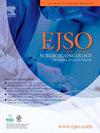早期乳腺癌的腋窝手术:对德国三所经认证的大学乳腺癌中心进行的关于前哨淋巴结活检遗漏的insema试验的现实分析
IF 2.9
2区 医学
Q2 ONCOLOGY
引用次数: 0
摘要
最近的试验,如INSEMA和SOUND,已经证明了在激素受体阳性、her2阴性的早期乳腺癌患者中省略前哨淋巴结活检的肿瘤学安全性。然而,在常规临床实践中辅助治疗决策的意义尚不清楚。方法:我们进行了一项来自大学乳腺癌中心的回顾性多中心队列研究,分析了2020年至2024年间诊断出符合INSEMA标准的867例患者:cT1, G1-2,年龄≥50岁,临床淋巴结阴性,接受保乳手术。我们评估了病理阳性淋巴结的发生率,术后肿瘤分期或分级升级的频率,以及对辅助治疗决策的潜在影响,包括CDK4/6抑制剂的适应症,继发腋窝手术或放疗。结果前哨淋巴结活检显示14.3% (n = 124)的患者有隐匿性淋巴结转移,排除微转移和分离肿瘤细胞后的假阴性率为10.5%。在11.6%的病例中,淋巴结阳性导致相关的治疗改变,包括化疗、腋窝放疗或潜在的辅助CDK4/6抑制剂治疗。此外,由于术后肿瘤特征升级,18.8%的患者需要进行二次腋窝手术。使用CDK4/6抑制剂预防一次侵袭性复发所需的手术数量因年龄和临床肿瘤大小而有显著差异,范围从1:33(最大值)到1:111(最小值)。结论:虽然在选定的患者中省略前哨淋巴结活检似乎是安全的,但我们的真实世界数据表明,除非使用其他预后测试(如基因表达谱),否则腋窝分期对指导个性化治疗仍具有临床相关性。本文章由计算机程序翻译,如有差异,请以英文原文为准。
Axillary surgery in early breast cancer: real-world analysis of the INSEMA-trial at three certified university breast cancer centers in Germany regarding the omission of sentinel lymph node biopsy
Background
Recent trials such as INSEMA and SOUND have demonstrated the oncological safety of omitting sentinel lymph node biopsy in selected patients with hormone receptor-positive, HER2-negative early breast cancer. However, the implications for adjuvant treatment decisions in routine clinical practice remain unclear.
Methods
We conducted a retrospective multicenter cohort study from university breast cancer centers, analyzing 867 patients diagnosed between 2020 and 2024 who met INSEMA criteria: cT1, G1-2, age ≥50 years, clinically node-negative, undergoing breast-conserving surgery. We evaluated the incidence of pathologically positive lymph nodes, frequency of postoperative upgrades in tumor stage or grading, and potential impact on adjuvant therapy decisions, including indications for CDK4/6 inhibitors, secondary axillary surgery or radiation.
Results
Sentinel lymph node biopsy revealed occult lymph node metastases in 14.3 % (n = 124) of patients, with a false-negative rate of 10.5 % when micrometastases and isolated tumor cells were excluded. In 11.6 % of cases, nodal positivity led to relevant therapeutic changes, including chemotherapy, axillary radiation, or potential adjuvant CDK4/6 inhibitor therapy. Moreover, 18.8 % of patients would have required secondary axillary surgery due to postoperative upgrades in tumor characteristics. The number needed to operate to prevent one invasive recurrence with CDK4/6 inhibitors varies significantly based on age and clinical tumor size, ranging from 1:333 (maximum) to 1:111 (minimum).
Conclusion
While omission of sentinel lymph node biopsy appears safe in selected patients, our real-world data suggest that axillary staging retains clinical relevance for guiding personalized treatment, unless other prognostic tests like gene expression profiles are used.
求助全文
通过发布文献求助,成功后即可免费获取论文全文。
去求助
来源期刊

Ejso
医学-外科
CiteScore
6.40
自引率
2.60%
发文量
1148
审稿时长
41 days
期刊介绍:
JSO - European Journal of Surgical Oncology ("the Journal of Cancer Surgery") is the Official Journal of the European Society of Surgical Oncology and BASO ~ the Association for Cancer Surgery.
The EJSO aims to advance surgical oncology research and practice through the publication of original research articles, review articles, editorials, debates and correspondence.
 求助内容:
求助内容: 应助结果提醒方式:
应助结果提醒方式:


